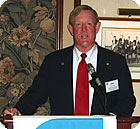
During the Gas Appliance Manufacturers Association (GAMA)
meeting in St. Petersburg, Fla., May 5-8, Jack Klimp, GAMA president, addressed
key issues with the membership including the exploration of a merger between
GAMA and the Air-Conditioning and Refrigeration Institute.
Bill Rafferty, GAMA chairman, and executive vice president of Mestek Inc., devoted a portion of his opening speech to the subject during the recent GAMA Annual Meeting. He and Jack Klimp, GAMA president, also made visits to every product division meeting during the course of two days. In addition, Robert Wilkins, chairman of ARI, and president of Danfoss, was actively seeking feedback on behalf of ARI. Many manufacturers are members of both associations.
As background, 10 current and former chairmen of both associations formed a study group and met at the most recent AHR Expo in Dallas, Jan. 29-31.
Representing ARI was: current chairman, Wilkins; Geraud Darnis, president of Carrier Corp.; Dave Pannier, president of Trane Residential Systems; Tom Bettcher, CEO of Emerson Climate Technologies; and Deborah Hawkins, president of Superior Coils. Representing GAMA was: Stu Farwell, president and CEO of Rheem Manufacturing Co.; Tom Huntington, vice president/general manager, Unitary Products Division of Johnson Controls; Ron Massa, executive vice president of A. O. Smith, Dan Holmes, chairman of Morrison Products; and Rafferty.
Rafferty said, “This study group formed three subcommittees with members from both associations to explore the potential benefits and hurdles to a possible combination. These committees held their deliberations and met with the study group about six weeks later. They reported that there appeared to be more benefits than hurdles to a combination. Most importantly, they found close alignment of interests on the issues most affecting both associations - energy and the environment.”
At that point, the study group recommended the executive committees and boards of both associations proceed with the process and develop details of a proposed consolidated organization for the membership’s consideration.
“We want to emphasize that no decision has been made and we want and need to consult with our full membership on this. Our goal is to reach a consensus on a final recommendation to the associations by early August,” said Rafferty.
The purpose of the discussions is to decide whether a combined organization would be more effective for the benefit of all members rather than if the two remained separate.
Klimp told product divisions during his visits that several times in the past years the possibility of combining GAMA and ARI has been discussed. “Subcommittees were recommended to examine potential benefits or pitfalls in three specific areas: government affairs, certification, and staff and administration,” said Klimp.
ARI and GAMA share as members about 30 larger companies. The study group discussed the implications of a significantly larger combined organization able to represent the interests of all members, both large and small.
Klimp said, “The big hurdle is the question of not disenfranchising the smaller companies. Everything else is simply a task with regard to the merger of any two groups, such as, retirement, labor, or administration.”
Between the time of the GAMA annual meeting and July 31, several focus groups are being scheduled at which time a straw man of the proposed new governance will be presented. A report is due back to the study group on Aug. 3. The study group will provide a recommendation to the associations.
Any move toward the combination or merger would require a vote of the two memberships. GAMA, which is incorporated in Illinois, is only required in its bylaws to require a two-thirds vote of the board of directors. Klimp noted, however, that GAMA would ask for a vote of the entire membership (as will ARI) should that point be reached.
Publication date:06/11/2007

Report Abusive Comment